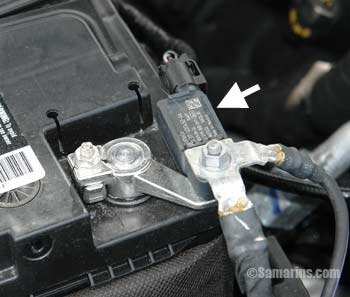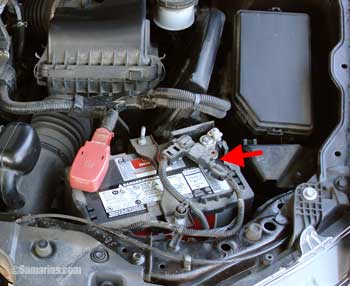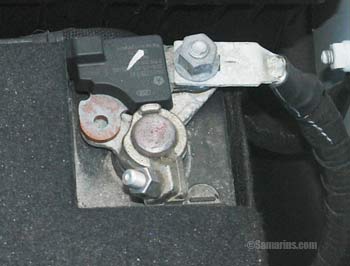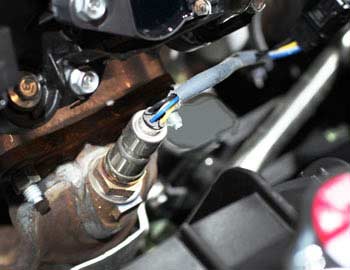Battery sensor: how it works, problems, checking, battery replacement
Updated: August 01, 2021
Many modern cars have a battery current sensor. It might also be called a battery management or monitor sensor, or simply a battery sensor. Often, it is installed on the negative battery terminal or on the cable.
In some cars, it might be installed on the positive terminal. Some cars have two battery sensors, one on each terminal. How the battery sensor works: it measures the current to and from the battery. The sensor may also monitor the voltage, state of charge and state of health of the battery (aging). In some cars, it even measures the temperature of the battery.
The vehicle computer (BCM or PCM) uses these inputs to precisely adjust charging system voltage, idle speed and other parameters for better fuel efficiency and longer battery life. This system is called Power or Battery Management System or BMS. If the system detects that the battery is getting weak, it may turn off some electrical accessories (load shedding), such as the navigation, heated steering, heated seats, etc., to save the battery power. In this case, the computer will display a warning message on the instrument panel.
Many electrical problems, including issues with the battery current sensor can be caused by loose or corroded battery terminals or moisture/corrosion around the battery sensor. To function properly, the battery sensor must be clean and dry, and the pole terminal must be tight.
Battery sensor problems
The most common problem is when the dirt, moisture or battery acid get into the sensor and damage or short it. For example, in some BMW vehicles, the battery is located in the side compartment in the trunk and water leaking onto the battery can damage the sensor. BMW calls it the Intelligent Battery Sensor, or IBS. A failed IBS is known to cause a variety of electrical problems, including a no-start. A battery sensor is a fragile device and can also be damaged when servicing or removing the battery.The Honda bulletin 16-026 for various Accord, Fit and HR-V models describes a problem where a faulty battery sensor can cause Charging System Indicator to come on with the trouble code (DTC) P154A. The bulletin advises changing the battery sensor. A faulty battery sensor can also cause the code P154A in some Acura vehicles.
Honda issued the recall (service bulletins 17-057 and 17-069) to check and, if needed, replace the battery management sensor in the 2013-2016 Honda Accord (except Hybrid). According to the bulletin 17-069, the moisture and road salt getting into the sensor "could result in an electrical short and, subsequently, a fire."
Advertisement
If a car has a battery current sensor and additional electrical accessories are connected directly to the battery negative terminal, it may cause problems, because the electric current will bypass the battery current sensor and its readings won't be accurate. For example, the owner's manual for the 2019 Ford Explorer advises not to connect any electrical device ground connection directly to the low voltage battery negative post to ensure proper operation of the battery management system (BMS).
In many vehicles, a bad battery sensor can cause the Stop/Start system not to work.
Replacing the battery sensor is not very expensive. An auto repair shop may charge you $50-$210 for the part plus $35-$110 labor. In some cars, a battery sensor comes together with the battery cable. The most difficult part is to diagnose the problem correctly, and it's not always easy.
Checking battery sensor
We looked at diagnostic procedures from several car makers, and they are all different. Some require measuring the resistance between the sensor pins, others advise using a scan tool to test the sensor. In some cars, using a scan tool, a mechanic can check the state of charge (SOC), the state of health and other parameters of the battery. You can find the proper diagnostic procedure in the service manual for your vehicle. We posted a list of websites offering paid access to service manuals for different cars at the bottom of this article.If there is a fault related to the battery sensor, the first step is to check it visually for corrosion, cracks, physical damage, loose battery terminals or battery cable connections, corroded pins at the connector or broken wires. If there are any added electrical accessories that are connected directly to the negative terminal bypassing the battery sensor, this may also cause problems.
Replacing/charging the battery in the vehicle with a battery sensor
There are some precautions when replacing the battery if a vehicle has the battery current sensor. For instance, some manufacturers advise to disconnect the battery sensor first, before disconnecting the negative battery terminal. It's also important to use the replacement battery of the correct type. For example, some vehicles with the Stop/Start system have an Absorbed Glass Mat (AGM) 12-volt battery, which is sensitive to overcharging. When replacing, the owner's manual may recommend using only the AGM battery.In some vehicles, a new battery might need to be "registered" with the battery management system using a scan tool (e.g. BMW). If the battery replacement is not registered, the battery (power) management system might not function properly. In some Ford vehicles, the battery management system might need to be reset after the battery has been replaced.
It is also important where to connect the wire clamps when boosting or charging the battery with a battery sensor. Considering all this, it might be a good idea to change the battery at a dealership. At least, check your vehicle owner's manual or do some research before replacing the battery.



